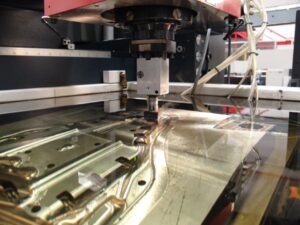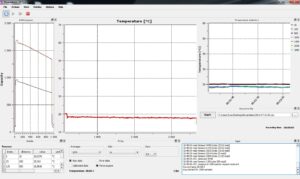 The continuous development of high-temperature fiber Bragg grating technology (FBG technology) promotes a significant increase in novel applications. For instance, nowadays FBG applications include such fields as “the temperature profiling of high-temperature manufacturing equipment, monitoring of fuel combustion machinery, temperature regulation of large diesel engines in trains, as well as assessment the structural integrity of a building post-fire”.
The continuous development of high-temperature fiber Bragg grating technology (FBG technology) promotes a significant increase in novel applications. For instance, nowadays FBG applications include such fields as “the temperature profiling of high-temperature manufacturing equipment, monitoring of fuel combustion machinery, temperature regulation of large diesel engines in trains, as well as assessment the structural integrity of a building post-fire”.
Additionally, high-temperature FBG technology is used in oil and gas industries where the resistance to the temperatures higher than 500 °C is totally recommended. To be more precise, the sensors based on fiber Bragg gratings are able to stand temperature conditions below and above 800 °C. Herewith, the thermal stability of FBG sensors depends closely on the intrinsic thermal stability of the core-cladding materials.
This is the reason why the development of fiber optic technology with higher thermal resistance, for example, the molten core technique, is still required. Thus, it was decided to apply a circular core/cladding glass optical fiber containing a yttrium-doped aluminosilicate core and a silica cladding in FBG sensors that may withstand about 900 °C.
The following types of FBG sensors are based on the nature of refractive index modifications induced by laser irradiation. The following types of FBGs are distinguished:
- The type I in fiber Bragg gratings produces a laser irradiation regime that emits an isotropic increase of the refractive index.
- The type II in FBGs, in its turn, has a connection with the creation of an anisotropic index change upon irradiation, generally emitted by the presence of nanogratings, and leads to the observation of form birefringence.
- Ultra-high temperature regenerated fiber Bragg gratings are able to operate above 800 °C in silica optical fibers. Therefore, these FBGs find their application in such areas as the profiling of high-temperature manufacturing equipment, dual pressure/temperature sensing for gas turbines, sodium-cooled nuclear reactors, high-temperature air flow meters for internal combustion engines and train engine temperature regulation.
- Femtosecond fiber Bragg gratings are made by ultrafast laser systems usually in the NIR spectral range, resulting in their use as temperature sensors for monitoring fluidized bed combustors, as well as for radiation-resistant temperature sensors.
- Sapphire fiber Bragg gratings allow achieving even higher temperature operation by using materials with higher melting points.
Optromix is a manufacturer of innovative fiber optic products for the global market. The company provides the most technologically advanced fiber optic solutions for the clients. Optromix produces a wide range of fiber optic devices, including cutting-edge customized fiber optic Bragg grating product line and fiber Bragg grating sensor systems. Moreover, Optromix is a top choice among the manufacturers of fiber Bragg grating monitoring systems. If you have any questions, please contact us at info@optromix.com


 Nowadays train accidents often cause severe injuries and even cases of death. Nevertheless, researchers from China have designed new
Nowadays train accidents often cause severe injuries and even cases of death. Nevertheless, researchers from China have designed new  The researchers from NASA Armstrong Flight Research Center form a partnership with members of the Naval Surface Warfare Center to create fleet maintenance capabilities with the help of new
The researchers from NASA Armstrong Flight Research Center form a partnership with members of the Naval Surface Warfare Center to create fleet maintenance capabilities with the help of new  The members of NASA company have decided to offer collaboration to companies providing
The members of NASA company have decided to offer collaboration to companies providing  Proper fire detection in the mining area is the number one priority because fire can evoke damages to valuable assets, downtime in operation, and even loss of lives. Herewith, the installation of fire protection devices can be complicated by harsh environmental conditions of the mining area because industrial equipment produces dirt, dust, humidity, and corrosive atmospheres in the production, storage, or transport of goods. Nevertheless, the application of modern
Proper fire detection in the mining area is the number one priority because fire can evoke damages to valuable assets, downtime in operation, and even loss of lives. Herewith, the installation of fire protection devices can be complicated by harsh environmental conditions of the mining area because industrial equipment produces dirt, dust, humidity, and corrosive atmospheres in the production, storage, or transport of goods. Nevertheless, the application of modern Nowadays researchers from California are planning to use “dark
Nowadays researchers from California are planning to use “dark  Recently a new simple low-cost technology has been developed for security monitoring of the borders. Initially, the technology that includes
Recently a new simple low-cost technology has been developed for security monitoring of the borders. Initially, the technology that includes  EDM or electrical discharge (spark) machining is the most advanced of metalworking technologies. EDM is worldwide used because of its high accuracy and machining applications where traditional metal removal is highly difficult or even impossible.
EDM or electrical discharge (spark) machining is the most advanced of metalworking technologies. EDM is worldwide used because of its high accuracy and machining applications where traditional metal removal is highly difficult or even impossible. Today all modern industries include highly complex and sensitive operations that require permanent operational conditions that are possible to provide due to the use of advanced technologies for temperature measurement. One of the potential solutions is the use of
Today all modern industries include highly complex and sensitive operations that require permanent operational conditions that are possible to provide due to the use of advanced technologies for temperature measurement. One of the potential solutions is the use of